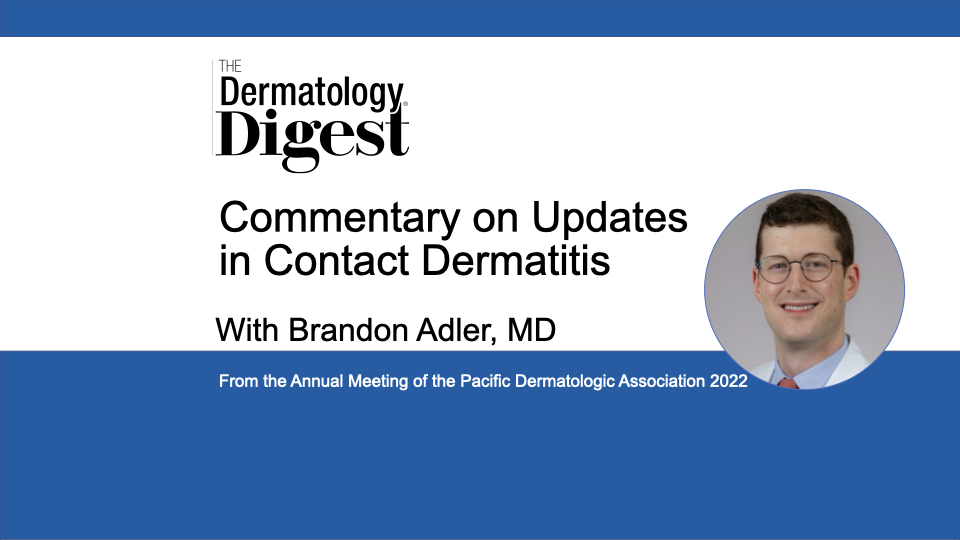Dr. Adler discusses what dermatologists need to know about three of today’s most relevant skin allergens, including aluminum, essential oils, and acrylates.
Brandon Adler, MD, Clinical Assistant Professor of Dermatology, Keck School of Medicine, University of Southern California, Los Angeles
“Every year the American Contact Dermatitis Society selects an allergen of the year to be highlighted based on changing prevalence or new sources of exposure. This year the allergen was aluminum, which is essentially ubiquitous in the environment and is in a number of products that we encounter on a daily basis,” said Brandon Adler, MD, who presented “Updates in Contact Dermatitis” during the Annual Meeting of the Pacific Dermatologic Association 2022.
Everything from electronic devices to foods, certain medications, cosmetics, sunscreens, orthopedic implants, and even tattoos may contain aluminum, according to Dr. Adler.
“Aluminum allergy, on the other hand, is thought to be quite uncommon relative to our known exposure. But there are a few very important scenarios to be aware of.”
The first has to do with vaccines. Fortunately, aluminum has nothing to do with the COVID vaccine, but a number of childhood vaccines contain aluminum, which is used as an adjuvant to help boost the immune response and form antibodies, said Dr. Adler.
“… this is an overwhelmingly safe use for aluminum. However, a small number of children are thought to become sensitized, or allergic, to aluminum following exposure to vaccines. The skin manifestation to be aware of is called persistent pruritic subcutaneous nodules, also known as vaccine granulomas.”
Vaccine granulomas can be itchy, and the subcutaneous nodules can persist for some time, said Dr. Adler. They develop with a delayed hypersensitivity reaction in the weeks—even years—following vaccination at the injection site.
“On exam you’ll generally see secondary changes—excoriation, pigmentary alteration, even hypertrichosis thought to relate to underlying, potentially severe pruritus.”
Importantly, despite the symptoms that can occur from vaccine granulomas, having the reaction is not a contraindication for children to receive future aluminum-containing vaccines, he said.
“The general guidance is that the benefits of vaccination and prevention of these key childhood diseases … outweighs the temporary but potentially prolonged pruritus associated with the reaction. In studies, the median time to resolution of this reaction can be as long as 18 to 49 months but, again, disease prevention is key, and it’s important to have educated, informed pediatricians to help patients make that decision.”
The second major manifestation of aluminum allergy has to do with aluminum in antiperspirants and deodorants. The usual cause of deodorant- or antiperspirant-associated allergic contact dermatitis is fragrance. Aluminum, itself, appears to be much less likely to be the cause, according to Dr. Adler.
“Still, for any patient presenting with axillary vault dermatitis—being any dermatitis involving the entirety of the central axilla and not just hovering at the periphery—there is a possibility of aluminum allergy. In that situation once it is confirmed by patch testing, you simply have the patient use an aluminum-free formulation.”
Essential Oils
Essential oils are widely encountered by patients in wellness products, “clean” beauty products, natural cleaning products, the air through diffusers and more, Dr. Adler said.
“There are nearly 80 different essential oils that have been reported to cause allergic contact dermatitis. In part, what we have to look out for is cross-reactivity among the essential oils. A patient sensitive to one may react to others they’ve never even been exposed to because of the chemical similarity.”
Two big drivers of that cross-reactivity are natural chemicals, terpenes, found in essential oils called limonene and linalool, he said.
“Limonene and linalool on their own are not particularly allergenic. But they oxidize upon air exposure to form hydroperoxides of limonene and linalool, which are quite potent allergens. In the North American Contact Dermatitis Group, we’ve been testing these hydrogen peroxides routinely on our screening series …and in the 2017-2018 cycle of patch testing across North America, nearly 9% of patients had positive reactions to linalool hydroperoxides. Linalool is most classically associated with lavender. Limonene hydroperoxides, which were positive in about 3% of patients patch tested, is classically associated with citrus oils. But they’re both found in a wide variety of essential oils.”
Skin contact is the classic exposure source for essential oils, but patients also have indirect contact through the air from diffusers, aerosolized room deodorizers, and cleaning products. That exposure generally presents with the airborne pattern of dermatitis, involving the eyelids, face, or exposed portions of the neck or upper extremities, Dr. Adler said.
Acrylates
“Acrylates usually start out as liquid monomers, which are quite potent allergens. Then they’re polymerized through a process usually involving heat or light to become theoretically nonallergenic hardened, fixed products. However, incomplete curing, which does occur, leaves behind residual monomer, which is very capable of triggering potent allergic reactions in sensitized patients.”
Newer and increasingly relevant sources of acrylate exposure include nail cosmetics—acrylic, gel, false, silk, and dipped nails. All contain (meth)acrylates or cyanoacrylates that can cause potent hand dermatitis, nail dystrophy, and occupational dermatitis in manicurists, he said.
“[Sensitization to acrylates] is a big problem when you think patients could be sensitized for life and may be exposed to acrylates from other diverse sources, including earbud headphones and EKG electrode leads, just to name a few. Other potential sources are medical adhesives, insulin pumps, glucose monitors, and dental work.”
Patients who initially become sensitized to acrylates through nail cosmetics might later develop significant reactions in the oral mucosa following dental work involving these allergens, Dr. Adler said.
“That can be quite traumatic and treatment refractory unless, in some cases as a last resort, the dental work has to be removed.”
Disclosures: Dr. Adler reports no relevant disclosures.


